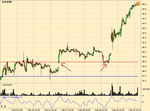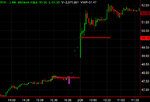DionysusToast
Legendary member
- Messages
- 5,965
- Likes
- 1,501
It seems there is some mystique around an opening GAP and how such a thing gets created.
There has been mention of different 'types' of GAPs - professional and amateur and how they can be detected by volume.
On the NYSE you have Floor Specialists. On the NASDAQ, there is no floor, it's a computer network. In this case you have Market Makers. The Market Makers & Specialists are in a very privileged position. They are arguably the best day traders on the planet. They do provide a very important service. That is to buy when nobody else is buying and sell when nobody else is selling. We should be very happy that they provide this service and appreciate their risks in doing this.Of course, there are benefits to being an MM, they don't do this for charity.
Let's consider a gap down. The price at which a stock opens cannot be set by any one specific individual/orgnisation. A stock cannot gap down from $40 to $37 if you or I have a bid at $39. The highest bid at the open will be the lowest price the stock can gap down to. It doesn't matter who's bid it is - you, me, Goldman Sachs, UBS, Deutsche Bank - whoever has the highest bid at the open will have set the lowest possible open price.
Now - let's say a company has terrible earnings, lowers guidance and announces suspension of dividends and there appears to be a lot of selling pressure lined up at the open with no sight of any buyers. In this case, the MM needs to be buyer of last resort and absorb all of the selling. Let's say this was you. Let's say you had to buy all shares that were being thrown at you and the close of yesterday was $40. What would you offer all these people for their shares ? Would you offer $41 ? Of course not. You would probably attempt to set a price that did the following :
1 - Put people off selling their shares
2 - Attracted bargain hunters to buy shares
3 - Gave you a reasonable chance of selling the shares at a higher price later on
You also have to set a 'reasonable' price, so you can't just offer .01 cents for the shares and hope no-one takes you up on it.
Now - what qty does the MM put alongside their bid on that initial offer ? What would you do ? Would you offer 1000 lots at that price, so that someone can immediately dump 100,000 shares on you ? Or would you just offer 1 lot to give you the chance to move your bid down if there was massive selling ?
More than likely - the professional thing to do would be to bid well below the close (say $37) and at small quantity because there is no sense in buying lots of lots.
Let's consider another scenario. Let's consider the same open but where a single retail trader has a bid at $39.50. The MM can still see that there is much more size on the ask. He'll ignore the fact that someone has a bid at $39.50 and more than likely do exactly the same thing. He'll bid $37 and 1 lot. In this case, the open will be $39.50 but the stock will immediately moved down to $37.
In both scenarios, the initial order was for 1 lot. The opening price was different and the gap size was different. After that first trade though - you have the same market.
Another interesting thing you'll see (and I AM jumping to conclusions here) is the "1 lot pre-market trade". That's when just 100 shares go through during the pre-market, effectively changing the last price. My presumption when I see this, is that this is probably the MM selling himself some shares through 2 different ECNs to set the price. I could be wrong about this though.
There has been mention of different 'types' of GAPs - professional and amateur and how they can be detected by volume.
On the NYSE you have Floor Specialists. On the NASDAQ, there is no floor, it's a computer network. In this case you have Market Makers. The Market Makers & Specialists are in a very privileged position. They are arguably the best day traders on the planet. They do provide a very important service. That is to buy when nobody else is buying and sell when nobody else is selling. We should be very happy that they provide this service and appreciate their risks in doing this.Of course, there are benefits to being an MM, they don't do this for charity.
Let's consider a gap down. The price at which a stock opens cannot be set by any one specific individual/orgnisation. A stock cannot gap down from $40 to $37 if you or I have a bid at $39. The highest bid at the open will be the lowest price the stock can gap down to. It doesn't matter who's bid it is - you, me, Goldman Sachs, UBS, Deutsche Bank - whoever has the highest bid at the open will have set the lowest possible open price.
Now - let's say a company has terrible earnings, lowers guidance and announces suspension of dividends and there appears to be a lot of selling pressure lined up at the open with no sight of any buyers. In this case, the MM needs to be buyer of last resort and absorb all of the selling. Let's say this was you. Let's say you had to buy all shares that were being thrown at you and the close of yesterday was $40. What would you offer all these people for their shares ? Would you offer $41 ? Of course not. You would probably attempt to set a price that did the following :
1 - Put people off selling their shares
2 - Attracted bargain hunters to buy shares
3 - Gave you a reasonable chance of selling the shares at a higher price later on
You also have to set a 'reasonable' price, so you can't just offer .01 cents for the shares and hope no-one takes you up on it.
Now - what qty does the MM put alongside their bid on that initial offer ? What would you do ? Would you offer 1000 lots at that price, so that someone can immediately dump 100,000 shares on you ? Or would you just offer 1 lot to give you the chance to move your bid down if there was massive selling ?
More than likely - the professional thing to do would be to bid well below the close (say $37) and at small quantity because there is no sense in buying lots of lots.
Let's consider another scenario. Let's consider the same open but where a single retail trader has a bid at $39.50. The MM can still see that there is much more size on the ask. He'll ignore the fact that someone has a bid at $39.50 and more than likely do exactly the same thing. He'll bid $37 and 1 lot. In this case, the open will be $39.50 but the stock will immediately moved down to $37.
In both scenarios, the initial order was for 1 lot. The opening price was different and the gap size was different. After that first trade though - you have the same market.
Another interesting thing you'll see (and I AM jumping to conclusions here) is the "1 lot pre-market trade". That's when just 100 shares go through during the pre-market, effectively changing the last price. My presumption when I see this, is that this is probably the MM selling himself some shares through 2 different ECNs to set the price. I could be wrong about this though.
Last edited:










